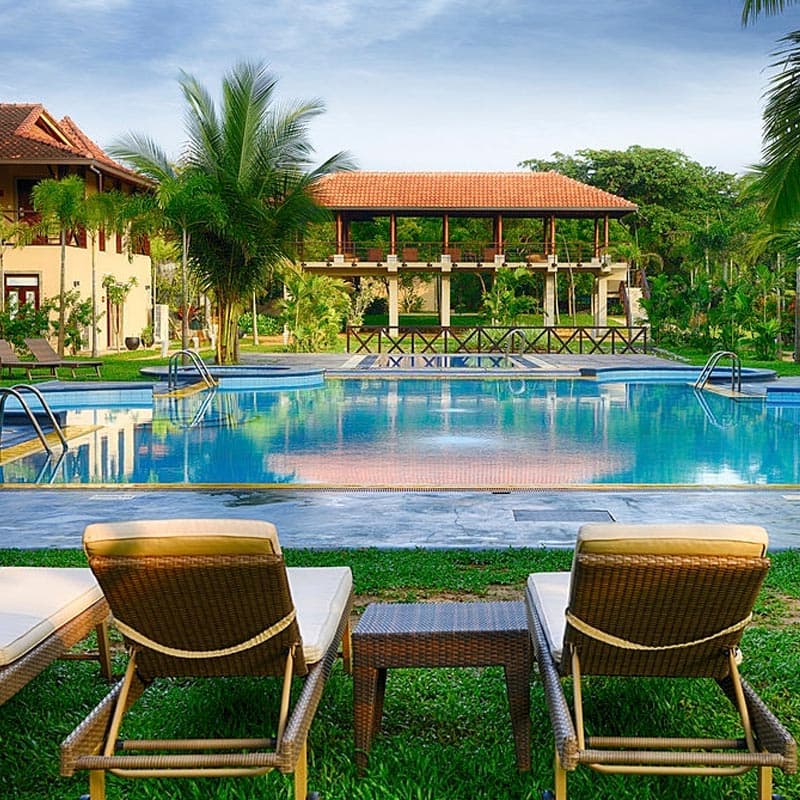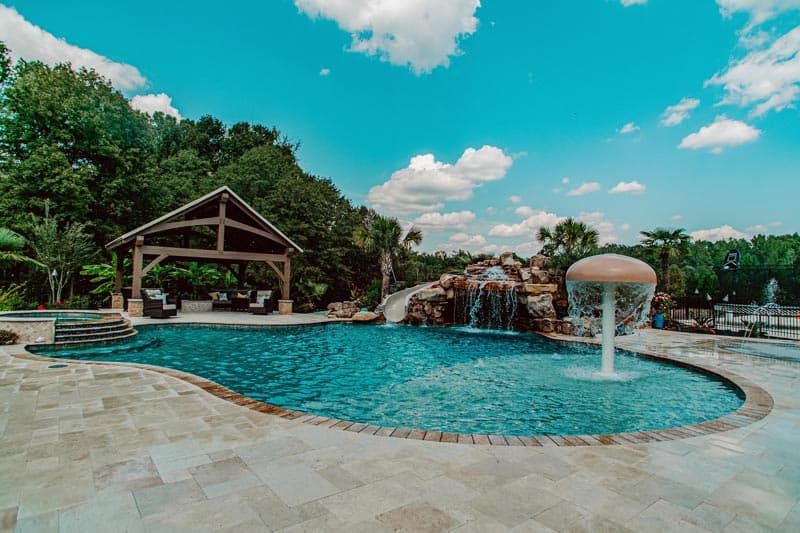How To Service An Inground Swimming Pool
There is one thing hair, grass, and pools have in common: they all need maintenance.
Everyone is drawn to that clear blue water that makes the sunrays playfully shimmer on it. Every once in a while, this pavlovian reaction to heed the call and go for a dip in the pool is only hindered by an untidy pool. An inground swimming pool occasionally requires your attention and should be considered a mandatory chore, like mowing the lawn or getting a haircut.
Servicing a concrete or vinyl liner swimming pool takes a few steps and procedures that are not difficult to achieve, once you start getting in the habit of going through them. So let’s take a look at how to start that habit.
Servicing Your Swimming Pool
Your outdoor living space is an absolute place of relaxation, with shrubs, scented flowers, trees, water features, and outdoor accessories within arm’s reach. However, it’s only the proper planning and thoughts that help create a beautiful outdoor living space.
Water: Clean pool water gives any pool a long-lasting life and saves you a lot of additional hassle, such as hardware replacement due to mineral build-up or corrosion. With all the pollutants and contaminants that can affect you, your guests, and your family, it is very important to keep the water clear and balanced.
Interior: The walls of your pool are a good reflection of everything your water comes in contact with. Mold, algae, debris are not welcome guests in the pool, so keeping a clean pool interior is the best security system to keep them out.
Filter system: If unwanted elements do end up in your pool, they are being filtered by the pool’s filter system. No one wants to swim in a cloudy and unclear mess of water. A good filter system will keep your pool water tidy. Depending on what you know your pool is most vulnerable to, your filter setup can include a sand filter, a cartridge filter, and a D.E. filter (diatomaceous earth).
Skimmers & Returns: Pool skimmers pool dirty water in the filter to clean it, whereas the returns send the newly cleaned water back out in the pool. Easy and mandatory! But they have to be clean in order to carry out their functions successfully.

Water Levels
The opening of the skimmer will show you exactly where the water level in your pool lies. Ideally, it should be kept within 1 inch between the midpoint and the top of your skimmer’s opening. Or, easier to memorize, it should stay underneath the lowest pool return.
For tiled pools, make sure the water level stays below the tiles, during off-season.
We advise against draining your pool entirely, unless you are undergoing a major fixture. Should you feel on the fence about it, talk to a professional about whether or not it truly is necessary. Draining a pool by yourself can cause more unforeseen damage if not done correctly.

Your Pump and Filter System
Before calculating how long your pool pump should run, be aware of the overall water quantity in your pool. A pump’s flow rate determines how much water a pump can filter in a preset time period. It is measured in gallons.
There are 3 types of pumps:
One-speed pumps have a single flow rate, so you don’t have to change any other settings.
Two-speed pumps, as their name suggests, have two set options between which you can switch back and forth.
Variable-speed pumps are good for conserving energy, as they allow you to change the flow rate more flexibly.
The turnover rate is measured in hours, and indicates the time it takes the pump/filter systems to cycle the water in the pool. To know exactly how many hours are needed for the turnover, divide the water quantity in the pool by the flow rate.
Basically, the amount of gallons divided by gallons per hour will result in the amount of hours…which are usually between 4 and 7 hours, for most pools. Put aside a larger budget if you own a concrete pool, as they usually require 2 turnovers.
Clearing Out Debris And Skimmers
Bugs are just as attracted to water as surfers are to waves. Since most of them are visible, you can easily fish them out with a telescopic pole and skimmer net. If you have trees nearby, leaves will also find their way into the water. It might be easier to consider trimming the branches around the pool, so you have less leaves to fish out.
Aside from bugs and leaves, an automatic vacuum robot will take care of other harder-to-get-to debris in your pool. Automatic vacuum robots look like small versions of underwater R2D2’s, and peruse the pool until it is clean and to your liking. Make sure to follow its manufacturer’s instructions.
When there are still small particles that the vacuum or skimmer have a hard time catching, you may want to consider flocculants or pool clarifiers. Flocculants are chemicals that, when added to your pool water, clump microscopic particles together, turning them into bigger particles that you can then fish out yourself. A pool clarifier is also a coagulant, like a flocculant, but milder. A pool clarifier can take days to have an effect, whereas flocculants work instantly but contain more chemicals.
Maintaining Water Chemistry
Finally, a form of chemistry which does not require you to be an actual scientist. Basic pool chemistry is more like pool ingredient etiquette.
The water testing kit is the first important tool to understand what is in your water, what affects it, and in what ways. These are the statistics you have to look for when delving into your pool water’s chemistry:
- Sanitizer levels: Your pool water is kept clean by such chemicals as chlorine or bromine. Depending on the type of sanitizer being used, the sanitizer level keeps a balance between the chemical quantities found in your pool water.
- pH levels: The balance between how acidic or basic your pool water is. The higher the pH level, the more basic and less acidic. An ideal pH level ranges between 7.2 to 7.8. The more in the middle, the better.
- Alkalinity: Keeps acidity or basicity at appropriate levels, avoiding spikes. Aim for an alkalinity level between 80 to 150 parts per million (ppm). You can even use baking soda to increase this level.
- Calcium hardness: Calcium is also found in the chemicals necessary for maintaining your pool water chemistry. If you own a concrete or vinyl pool, a good calcium hardness range is 200-400 ppm. For fiberglass pools, a range of 100–300 ppm would be ideal.
- Stabilizer: Also scientifically known as cyanuric acid, this level is best to stay between 20–50 ppm.
- Chlorine: We all know chlorine is a major chemical used in pool water, but in order for it to not be too toxic, its level should stay between 2.0–3.0 ppm
Ask a pool water expert to assess if there are any other chemicals necessary for your pool water to maintain a healthy chemistry. They will explain more about how other chemicals can help.
Brushing The Bottom Of the Pool
This task is as easy to accomplish as it is important for pool water health. Ideally, you should brush the bottom of your pool once a week.
For instance, concrete pools are the most likely to gather algae, which affects all the levels of the pool water chemistry you worked so hard to maintain.
Pool brushes can be attached to the same telescopic pole you use for your skimmer. It is basically a long, underwater broom. Concrete pools get cleaned easier if the brush is made of stainless steel. Nylon pool brushes are more suitable for fiberglass or vinyl liner pools. If you decide to use a professional pool cleaning service, you won’t have to worry about any of this. Avoid heavy-duty or sharp tools, as they may scratch and damage the bottom of your pool.
Healthy Pool, All is Cool
Everything we use on a regular basis needs occasional servicing. This ensures a longer life and less to spend on repairs. The pool is an exposed part of a property and needs to be treated frequently. Nothing too time-consuming, especially once you get into the habit of following the necessary steps. One at a time.
But in regards to time, not everyone can afford to spend what little is left of it on pool servicing. If you live in Georgia and would like a team of professionals to take this task off your hands, call White’s Pools at 844-7-POOLMAN today, or simply fill out our contact form. We would be glad to help you maintain the aspect of the nicest pool on the block.